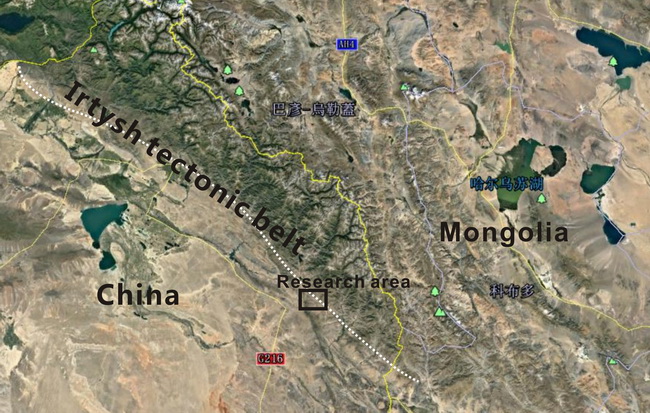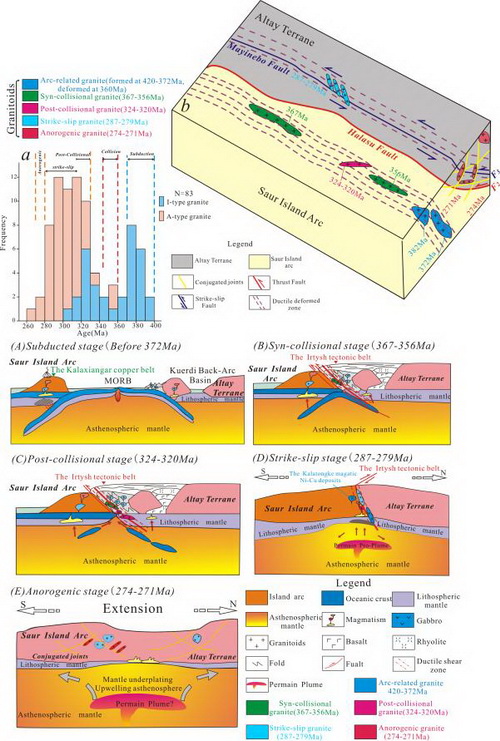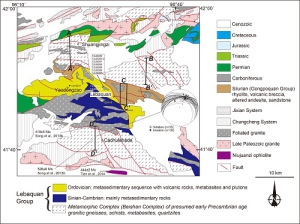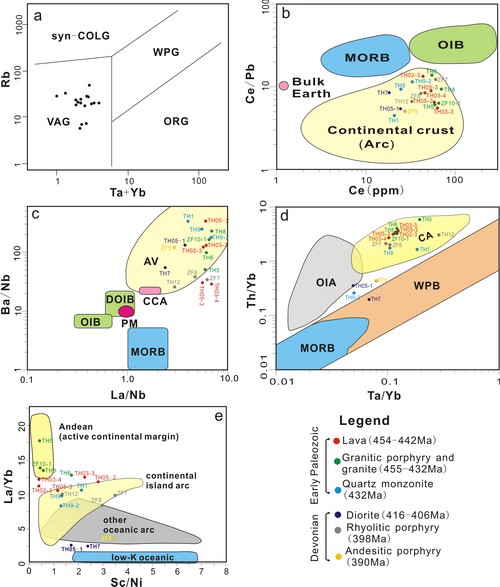Researchers Define the Tectonic Texture and Evolution of the Irtysh Tectonic BeltUpdate time:03 23, 2017
The sketch map of eastern Irtysh tectonic belt.(Image by HONG Tao's group) Precise geochronological constraints of the Irtysh tectonic belt situated between the Saur Island Arc and the Altay Terrane are crucial to a better understanding of the tectonic evolution of the Central Asian Orogenic Belt (CAOB). PhD Candidate HONG Tao from IGG, sponsored by Prof. XU Xingwang and GAO Jun, established the texture and evolution of the Irtysh tectonic belt. This study shows that the collision between the Saur Island Arc and the Altay Terrane occurred in the Early Carboniferous (ca. 367-356Ma) and the subsequent post-collisional tectonic process continued to the Late Carboniferous (ca. 324–320Ma). It is further suggested that the Irtysh tectonic belt underwent large-scale strike-slip deformation during the mid-Permian between 287 and 279 Ma. The termination of the Irtysh tectonic belt orogeny is thought to have also occurred during the mid-Permian between 274 and 271 Ma. This work was published in LITHOS.(Link) The Central Asian Orogenic Belt (CAOB, also known as Altaids) is situated between the European, Siberian, North China and Tarim cratons, and is one of the largest accretionary orogens and Phanerozoic continental growth regions in the world. The CAOB is thought to have formed by multiple accretion and collision events of various microcontinents, island arcs, oceanic plateaus and accretionary wedges due to the closure of the Paleo-Asia Ocean. The Irtysh tectonic belt is located in the middle-western part of the CAOB and is generally thought to be the result of the collision of the Saur Island Arc and the Altay Terrane, which occurred following the consumption of the Paleozoic Zaysan-Irtysh Ocean, a branch of the Paleo-Asia Ocean. Therefore, precise geochronological constraints of the Irtysh tectonic belt are crucial for a better understanding of the tectonic evolution of this tectonic belt and will provide constraints on the evolution of the CAOB. The contribution reported the results of a detailed field investigation of the Irtysh tectonic belt. Various granitoids of different tectonic stages were identified, including arc-related granodioritic porphyries, collisional granitoids along and crosscutting the schistosity of the metasedimentary country-rocks, and granitic dikes exposed along strike-slip faults and conjugate tension joints. Furthermore, a combined study including Laser Ablation-Inductively Coupled Plasma-Mass Spectrometry (LAICP- MS), SIMS zircon U–Pb dating and Hf isotopes was performed on these granitoids to unravel the tectonic evolution of the Irtysh tectonic belt. The study was done in collaboration with GeoZentrum Nordbayern, Universität Erlangen-Nürnberg, Erlangen, Germany. The work was supported by the National Natural Science Foundation of China (Grant Numbers 41390442 and 41390445).
Figure: A simplified tectonic model of the Middle-to Late-Paleozoic evolution of Kalaxiangar tectonic belt (eastern Irtysh tectonic belt) (Image by HONG Tao's group)
|
Contact
HONG Tao
Division: Solid Mineral Resources Key Laboratory of Mineral Resources Phone: +86-010-82998198 E-mail: hongtao7413@163.com Related Articles
Reference
|
-
SIMSSecondary Ion Mass Spectrometer Laboratory
-
MC-ICPMSMultiple-collector ICPMS Laboratory
-
EM & TEMElectron Microprobe and Transmission Electron Microscope Laboratory
-
SISolid Isotope Laboratory
-
StIStable Isotope Laboratory
-
RMPARock-Mineral Preparation and Analysis
-
AAH40Ar/39Ar & (U-Th)/He Laboratory
-
EMLElectron Microscopy Laboratory
-
USCLUranium Series Chronology Laboratory
-
SASeismic Array Laboratory
-
SEELaboratory of Space Environment Exploration Laboratory
-
PGPaleomagnetism and Geochronology Laboratory
-
BioMNSFrance-China Bio-mineralization and Nano-structure Laboratory

 Print
Print Close
Close



